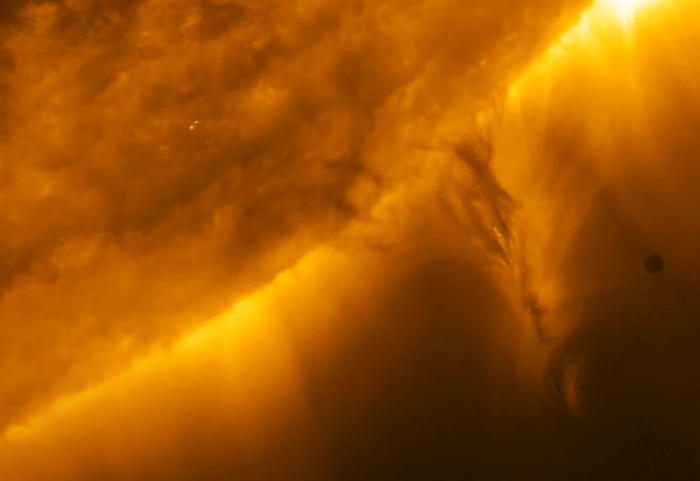The dramatic motion of Mercury across the front of the Sun was captured.
The European Space Agency (ESA) recently released images of the Sun and Mercury captured by the solar probe ‘Solar Orbiter’ through its official website.
The video was taken by the EUI (extreme ultraviolet imaging device) mounted on the ‘Solar Orbiter’. Taken precisely on January 3, the frame captures Mercury moving right from center against a backdrop of hot atmosphere rolling across the Sun’s surface.
Mercury, which looks like a round shadow, orbits an average distance of about 58 million km from the Sun. Astronomical observatories around the globe also tend to capture this dramatic situation when Mercury transits between the Sun and the Earth.
An ESA official explained, “The phenomenon in which a celestial body crosses in front of another celestial body, such as Mercury passing through the sun, is called transit.”
The transit method basically uses the motion of the planets between the stars and the Earth. If there is a planet B orbiting A between the star A and the Earth, there will be a moment when the light of A is slightly covered when viewed from Earth. If this phenomenon is observed periodically, it can be determined that B orbits around the main star A.
An ESA official said, “It is common for transits to be repeated several times with the same cycle.” “Observing the transit period of a planet or the luminosity curve of a star (a curve representing the luminosity of a celestial body that changes over time) indicates not only the orbital period of the planet, but also the orbital period of the planet. Information such as diameter and presence of an atmosphere can be obtained indirectly,” he said.
In the case of Doppler spectroscopy, the phenomenon that the frequency and wavelength change according to the relative speed of the source of the wave and the observer is used. Stars and planets orbiting them attract each other with their gravitational pull, and exoplanets are observed through the tremors that occur in the stars according to the position of the planets.
Compared to Doppler spectroscopy, the transit method, which has pros and cons, was used by NASA’s ‘Kepler Telescope’, which was discontinued in 2018. NASA’s ‘TES’ probe and ESA’s ‘CHEOPS’ space telescope also search for exoplanets using the transit method.
Reporter Jeong Ian [email protected]
⇨Go to Sputnik Naver Post
⇨Go to Sputnik YouTube Channel


